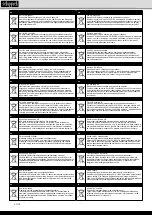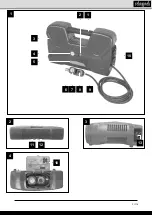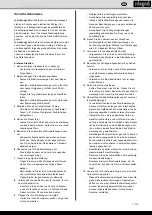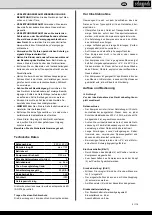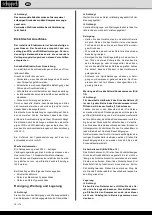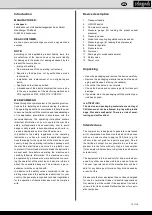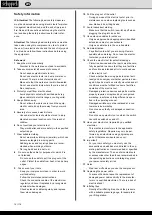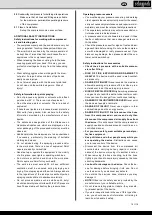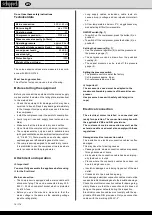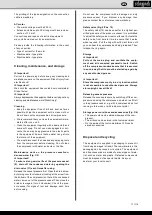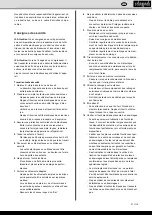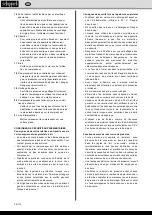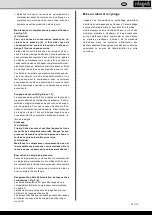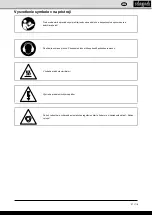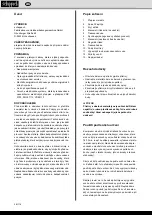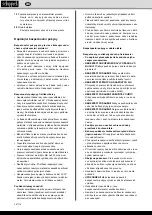
15 І 116
Operating pressure vessels
•
You must keep your pressure vessel in good working
order, operate the vessel correctly, monitor the vessel,
carry out necessary maintenance and repair work im-
mediately and meet the relevant safety precautions.
•
The supervisory authority may enforce essential con-
trol measures in individual cases.
•
A pressure vessel is not allowed to be used if it has
faults or deficiencies that can endanger workers or
third parties.
•
Check the pressure vessel for signs of rust and dam-
age each time before using. Do not use the compres-
sor with a damaged or rusty pressure vessel. If you
discover any damage, then please contact the cus-
tomer service workshop.
Safety instructions for accessories
•
Check the air pressure with a suitable manom-
eter after filling.
•
RISK OF FIRE, EXPLOSION AND DAMAGE TO
HEALTH!
The device must be used in well-ventilat-
ed areas only.
•
DANGER OF INJURY!
Never exceed the maximum
allowable working air pressure of 8 bar. Use a pres-
sure reducer to set the working air pressure.
•
RISK OF RECOIL FORCES!
High working pressures
can give rise to recoil forces that under certain condi-
tions can result in danger from continuous loading.
•
DANGER OF INJURY! IMPROPER USE!
Never point
the device at people or animals.
•
DANGER OF INJURY!
Never use oxygen or other
combustible gas as the energy source.
•
DANGER OF INJURY! First disconnect the hose
from the compressed air source and only then
disconnect the compressed air supply hose from
the device.
This will ensure that the compressed air
supply hose does not wave around or recoil in an un-
controlled manner.
•
For your own safety, wear suitable personal pro-
tective equipment.
•
Keep children and other people away while you
are operating the device.
Distractions can cause
you to lose control of the device.
•
Disconnect the device from the compressed air
source before carrying out any repairs or mainte-
nance of the device or moving it to another location.
•
When removing the hose coupling, hold the hose
tightly in your hand to avoid injury caused by the hose
shooting backwards.
•
Look out for damage on the device.
Check the de-
vice for damage before bringing it into use. Do not
use the device if you discover any defects.
•
Do not kink the device’s hose, otherwise you may
damage it.
•
NOTE!
Observe the safety advice provided by the
manufacturer of your inflatable article.
•
Do not remove rating plates or labels - they are safe-
ty-relevant parts of the device.
•
If you are inexperienced in the use of this type of de-
vice, you should seek out information or training to
learn how to handle it safely.
20
Roadworthy compressors for building site operations
–
Make sure that all lines and fittings are suitable
for the maximum permissible operating pressure
of the compressor.
21
Place of installation
–
Set up the compressor on an even surface.
ADDITIONAL SAFETY INSTRUCTIONS
Safety instructions for working with compressed
air and blasting guns
•
The compressor pump and lines can become very hot
during operation. Touching these parts will burn you.
•
The air which is sucked in by the compressor must
be kept free of impurities that could cause fires or
explosions in the compressor pump.
•
When releasing the hose coupling, hold the hose
coupling piece with your hand. This way, you can
protect yourself against injury from the rebounding
hose.
•
Wear safety goggles when working with the blow-
out pistol. Foreign bodies or blown off parts can
easily cause injuries.
•
Do not blow at people with the blow-out pistol and
do not clean clothes while being worn. Risk of
injury!
Safety information for paint spraying
•
Do not process any paints or solvents with a flash
point below 55° C. There is a risk of explosion!
•
Do not heat up paints or solvents. There is a risk of
explosion!
•
If hazardous liquids are processed, wear protective
filter units (face guards). Also, adhere to the safety
information provided by the manufacturers of such
liquids.
• The details and designations of the Ordinance on
Hazardous Substances, which are displayed on the
outer packaging of the processed material, must be
observed.
•
Additional protective measures are to be undertaken
if necessary, particularly the wearing of suitable
clothing and masks.
•
Do not smoke during the spraying process and/or
in the work area. There is a risk of explosion! Paint
vapors are easily combustible.
•
Never set up or operate the equipment in the vicinity
of a fire place, open lights or sparking machines.
•
Do not store or eat food and drink in the work area.
Paint vapors are harmful to your health.
•
The work area must exceed 30 m3 and sufficient
ventilation must be ensured during spraying and
drying. Do not spray against the wind. Always adhere
to the regulations of the local police authority when
spraying combustible or hazardous materials.
•
Do not process media such as white spirit, butyl
alcohol and methylene chloride with the PVC pressure
hose.These media will destroy the pressure hose.
GB
Summary of Contents for Air Case 5906118901
Page 3: ...3 116 1 1 5 3 4 2 2 11 12 6 7 8 9 10 3 13 4 10...
Page 4: ...4 116...
Page 48: ...48 116...
Page 112: ......
Page 113: ......


